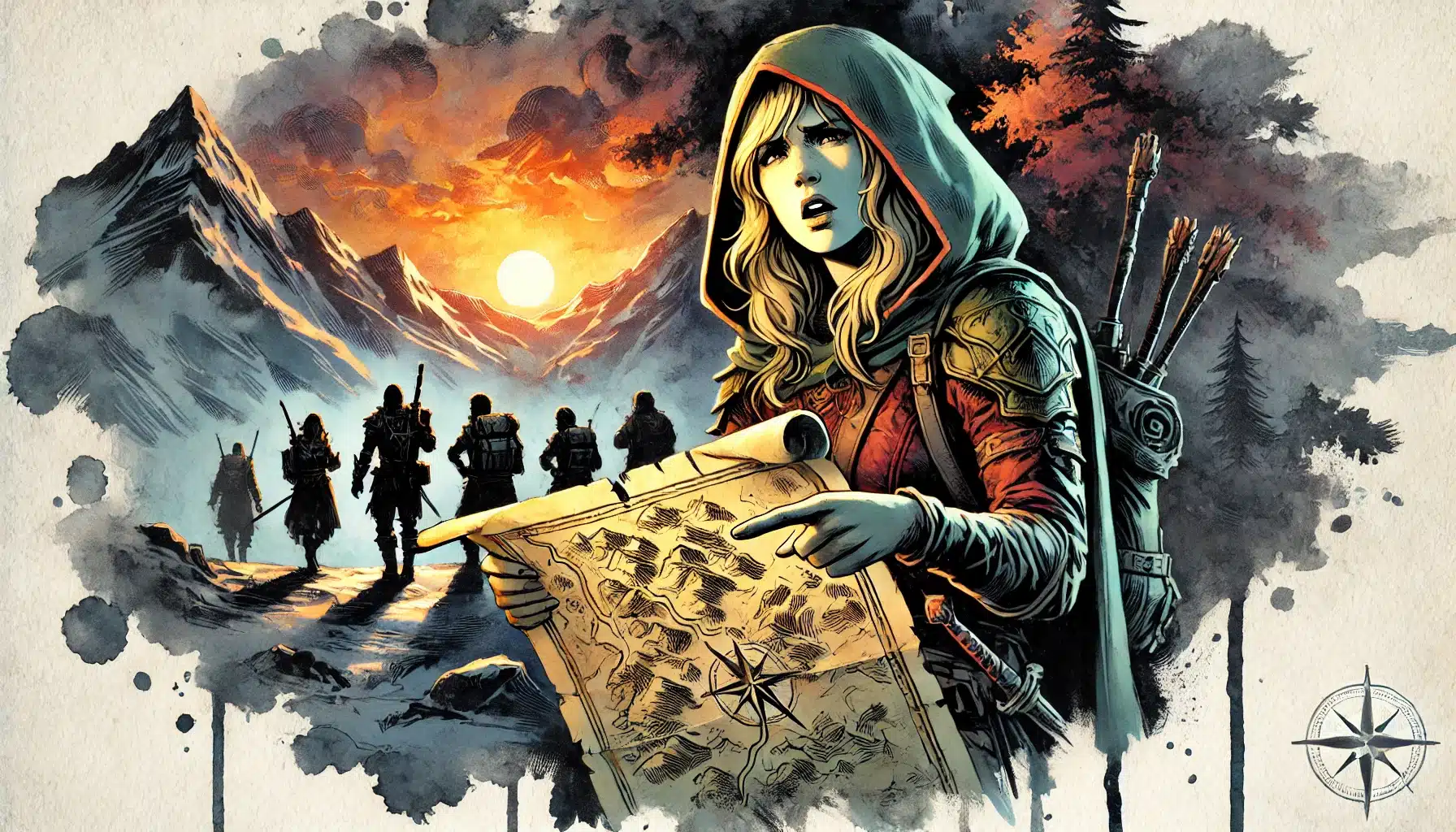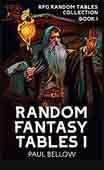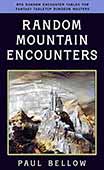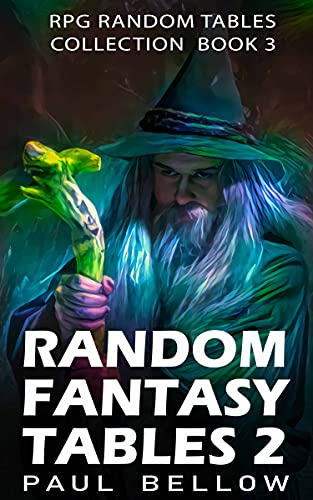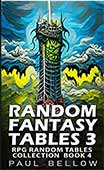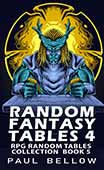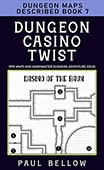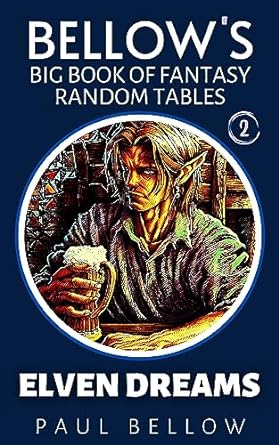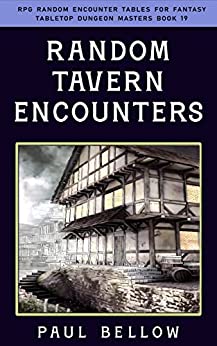Exploration in Dungeons & Dragons holds a unique allure, offering players the chance to uncover the unknown, uncover secrets, and immerse themselves deeply within a campaign’s setting. While exploration stands as one of the three core pillars of gameplay—alongside combat and roleplaying—the challenge remains in making it engaging and memorable. When not thoughtfully designed, exploration can become laborious and predictable, distracting from the vibrant experience that the game seeks to offer. This article explores the potential of gamification to breathe new life into exploration, transforming it into a rewarding and enjoyable aspect of D&D. By incorporating elements of gamification—such as puzzles, skill challenges, and dynamic environments—Dungeon Masters can create a sense of discovery that keeps players invested. These mechanics not only enhance immersion but also help spice up D&D encounters by introducing unexpected twists and meaningful choices. When executed well, gamified exploration fosters a deeper connection to the world, making each step into the unknown feel exciting and rewarding.
Gamification harnesses the principles of game design to motivate and reward behaviors through clear objectives and tangible outcomes. By integrating gamified mechanics into exploration, Dungeon Masters can create an environment where players are eager to delve deeper into the world around them. Whether they’re seeking hidden treasures, unraveling mysterious histories, or mapping new territories, players are drawn into the adventure with a palpable sense of purpose and excitement. Through innovations in storytelling and gameplay, exploration can evolve into a core element that enhances the campaign’s immersion and appeal.
A thoughtfully designed exploration system not only enriches world-building but also fosters character development and plot advancement. When players are fully engaged with the environments they traverse, they become more invested in their characters’ journeys, driving the narrative forward. Exploration can spark moments of introspection, encourage resourcefulness, and promote teamwork, weaving naturally into the overall story. The magic lies in creating opportunities for characters to grow and the plot to evolve organically, with each discovery revealing new layers of intrigue and opportunity.
However, Dungeon Masters often face challenges in maintaining player interest and pacing during exploration. Exploration can stall without the promise of tangible rewards or meaningful objectives, leading players to disengage or prioritize other aspects of gameplay. To combat this, DMs can utilize gamification techniques, such as milestones, achievements, and progress tracking, to incentivize players to explore with enthusiasm. By bringing these strategies to life, exploration transforms from a mere backdrop to a dynamic, integral pillar of the campaign.
Ultimately, the goal of gamified exploration is to create an atmosphere where players look forward to every moment spent discovering and interacting with their surroundings. The adventure becomes a shared experience, one that is both reflective of their own creativity and aligned with the campaign’s overarching themes. As we delve into specific mechanics and techniques, Dungeon Masters are invited to reimagine exploration not as a chore but as an opportunity for boundless discovery and wonder.
- The Importance of Exploration in D&D
- Gamifying Exploration: Key Concepts
- Reward Systems for Exploration
- Milestones and Achievements in Exploration
- Dynamic Exploration Challenges
- Progress Tracking and Exploration Maps
- Story-Driven Exploration Mechanics
- Incorporating Player Roles in Exploration
- Building Unique Exploration Rewards
- Encouraging Player Creativity in Exploration
- Scaling Exploration Mechanics for Different Campaign Styles
- Exploration as a Tool for Immersion
The Importance of Exploration in D&D
Exploration enriches D&D campaigns by imbuing them with a sense of wonder and discovery that captivates both players and characters alike. It invites adventurers to venture into uncharted territories, unravel the mysteries of forgotten civilizations, and uncover connections between disparate elements of the game world. Each exploration opportunity serves as a gateway to immersion, allowing players to deeply engage with the lore, landscapes, and myths woven into the campaign’s tapestry.
Try my AI Tabletop RPG generators...and an extensive library of content!
Exploration extends beyond the physical journey, offering potential for character development and growth. As players navigate new environments, they learn not only about the world but about themselves and their capabilities. Exploration encourages introspection and roleplay, allowing characters to confront personal challenges, overcome fears, and build relationships with fellow travelers. Whether through the discovery of a long-lost relic or the revelation of an ancient prophecy, exploration serves as a catalyst for personal transformation and shared experiences.
| Element | Description | Example Scenario |
|---|---|---|
| Cartography | Mapping out new territories and uncovering hidden paths | Discovering a forgotten city buried beneath the jungle canopy |
| Lore Discovery | Unveiling secrets of the world’s history, myths, and cultures | Deciphering ancient runes leading to a treasure trove |
| Environmental Challenges | Overcoming natural obstacles and adapting to diverse landscapes | Navigating a treacherous ravine during a fierce storm |
| Cultural Interactions | Engaging with various societies and traditions | Negotiating trade with a reclusive mountain tribe |
| Resource Gathering | Procuring essential supplies and materials | Harvesting rare herbs known for their healing properties |
| Hidden Treasures | Uncovering valuable and rare items hidden from sight | Finding a mystical gemstone with unique magical properties |
| Inspirational Landscapes | Experiencing awe-inspiring vistas and phenomena | Witnessing the aurora borealis-like phenomenon in icy wastelands |
| Dynamic Weather | Experiencing and adapting to unpredictable weather shifts | Surviving a sudden blizzard while crossing a mountain pass |
| Wildlife Encounters | Observing or interacting with regional fauna | Forming a temporary alliance with migratory magical creatures |
| Strategic Reconnaissance | Gaining insights into enemy movements or bases | Conducting a covert mission to scout an enemy fortress |
| Connections to Fate | Unraveling prophecies and aligning with destinies | Discovering a relic foretold to play a role in a grand prophecy |
| Interpersonal Dynamics | Building bonds with fellow adventurers | Unifying a team to overcome trials and tribulations together |
Despite these enriching aspects, DMs often encounter challenges when integrating exploration into gameplay. Player disinterest may arise if exploration feels aimless or lacking in rewards. Maintaining pacing and excitement during extended exploration sessions can prove difficult, risking the flow of the narrative. Additionally, poorly designed rewards may fail to incentivize exploration, leaving players disengaged.
To address these challenges, DMs are encouraged to view exploration as a story-driven experience, one that captivates players through tangible outcomes and purposeful objectives. By aligning player motivations with carefully crafted rewards, exploration becomes more than mere traversal—it evolves into a journey of discovery, immersion, and personal growth. Through this lens, exploration can capture the imagination of players, transforming it into an essential and beloved element of D&D campaigns.
Gamifying Exploration: Key Concepts
Gamification applies the principles of game design to engage and motivate participants by aligning well-defined objectives and rewards with their actions. In D&D, gamifying exploration enhances gameplay by creating a structure where players feel rewarded for their curiosity and achievements within the game world. By articulating clear goals, providing tangible incentives, and injecting elements of competition or fun, gamification elevates exploration from a background role to a centerpiece of player engagement.
⚔️ Fantasy RPG Random Tables Books
Make life as a Gamemaster easier…
If you play Dungeons & Dragons, Pathfinder, or other fantasy RPGs, this
RPG random tables series
is packed with encounters, NPCs, treasure, and more. Available in eBook or print—either way, you’ll have a wealth of adventure ideas at your fingertips.
- Reward Systems: Design rewards that vary, from immediate gratifications like magical items to long-term benefits such as unlocking new abilities or knowledge.
- Milestones: Set specific objectives that players strive to reach, creating a roadmap of progression through exploration.
- Achievements: Implement badges or titles to acknowledge players who discover hidden locations, perform notable deeds, or achieve personal goals.
- Progress Tracking: Use visual aids or tracking tools to capture and display player progress, ensuring clarity and motivation.
- Narrative Integration: Ensure exploration ties into the greater story, engaging players with meaningful contributions to the campaign.
- Dynamic Challenges: Introduce variability in exploration through shifting environmental conditions and evolving quests.
- Collaborative Engagement: Encourage player-driven exploration with opportunities for teamwork and problem-solving.
- Balanced Rewards: Consider player motivations, providing a mix of roleplay, story, and mechanical rewards.
- Player Agency: Allow players the freedom to make impactful decisions during exploration, affecting future outcomes.
- Thematic Consistency: Align exploration themes with the overall narrative, enhancing immersion.
- Unpredictable Outcomes: Infuse exploration with surprises, ensuring it remains exciting and dynamic.
- Skill Development: Offer opportunities for character and player growth, enhancing tactical and critical thinking skills.
By applying these gamification techniques, exploration evolves into an experience that feels purposeful and thrilling. Players are motivated to uncover landmarks and hidden secrets, prompted by the allure of achievements and the satisfaction of progress tracking. Simply put, gamification infuses exploration with energy and creativity, transforming it from being seen as a chore to an eagerly anticipated and cherished component of gameplay.
For example, hidden achievements for locating historical landmarks serve as both milestones and badges of honor. Progress trackers, like maps filled with markers or visual representations of terra incognita, provide a sense of accomplishment and perspective on players’ journeys. Ultimately, gamification ensures that exploration is imbued with purpose and joy, sparking curiosity and wonder while maintaining engagement and excitement.
Reward Systems for Exploration
Effective exploration rewards should resonate with player motivations, offering incentives that elevate the experience from mere exploration to a purpose-driven endeavor. Rewards can range from tangible treasure and valuable items to knowledge and story progression, each serving to enrich players’ engagement with the world and their characters’ journey.
| Reward Type | Description | Example |
|---|---|---|
| Magical Items | Unique artifacts or gear that enhance abilities | Discovering a ring that grants limited invisibility |
| Lore and Knowledge | Unveiling secrets, prophecies, or historical truths | Unearthing a hidden library containing ancient tomes |
| Plot Development | Unlocking new quests or advancing the central narrative | Gaining clues to foil a villain’s plan |
| Cultural Insights | Building understanding of diverse cultures and traditions | Participating in a ritual ceremony, gaining allies |
| Unique Abilities | Earning new skills or talents as a result of discoveries | Unlocking a meditation technique that enhances focus |
| Tactical Advantage | Securing strategic locations or resources | Establishing a hidden base within a natural fortification |
| Environmental Adaptation | Acquiring knowledge to thrive in various landscapes | Learning survival techniques for harsh deserts |
| Personal Transformations | Character growth through facing personal or moral challenges | Embracing a heroic destiny that shapes the character |
| Scouting Intelligence | Gaining insights into enemy movements or vulnerabilities | Discovering secret passageways within enemy territory |
| Local Legends | Becoming renowned or infamous for explorations | Earning a reputation as “The Wilderness Tamer” |
| Culturally Significant Artifacts | Securing objects of cultural or historical importance | Recovering a lost symbol of a forgotten kingdom |
| Ally Recruitment | Gaining followers or bonds through exploration | Convincing a wandering warrior to join the party |
| Environmental Manipulation | Learning ways to influence or control the environment | Uncovering a mystical cave that alters elemental energies |
| Exotic Creatures | Encountering rare animals or beasts | Forming a bond with a mythical falcon leading to aerial insights |
Well-crafted reward systems strike a balance between immediate and long-term gratifications, ensuring that players feel both an instant sense of accomplishment and a motivation to continue their explorations. Immediate rewards might include the discovery of a powerful magical artifact, while long-term incentives could entail gaining access to new quests or unlocking pivotal story arcs that hinge on the information gathered during exploration.
For example, players might uncover a hidden library within an ancient temple, gaining access to powerful spells or enhancing their understanding of a looming threat. Alternatively, discovering a rare artifact could provide tactical advantages in future battles or negotiations, emboldening players as they face daunting challenges. By offering a variety of rewards that cater to different player motivations, DMs can create a dynamic and multifaceted exploration experience that feels enriching and rewarding.
Ultimately, effective rewards elevate exploration beyond the mere acquisition of material wealth. They deepen players’ connections to the campaign world, offering insights into its history, culture, and mysteries. As players venture further into the unknown, their discoveries shape their journey, infusing moments of awe and revelation into the fabric of the narrative.
Milestones and Achievements in Exploration
Introducing milestones and achievements within exploration transforms it from a series of arbitrary tasks into a structured, engaging experience. Milestones offer players concrete objectives, guiding their journey with purpose, while achievements acknowledge notable accomplishments and provide an added layer of satisfaction.
- Finding Hidden Locations: Discovering secret sanctuaries, ancient ruins, or mystical springs.
- Mapping Terrain: Completing detailed maps of uncharted territories or regions of interest.
- Solving Environmental Puzzles: Overcoming obstacles through clever use of resources and knowledge.
- Cultural Exchange: Successfully engaging and forming alliances with unfamiliar cultures.
- Survival Mastery: Demonstrating proficiency and adaptability in harsh environments.
- Legend Discovery: Uncovering myths and prophecies entwined with the world’s fate.
- Unique Flora and Fauna Cataloging: Documenting rare species or peculiar ecosystems.
- Resource Extraction: Acquiring valuable materials or goods from new regions.
- Historical Reconstruction: Piecing together events or narratives from ancient artifacts.
- Risk Mitigation: Avoiding hazards or neutralizing prevalent natural threats.
- Relic Recovery: Securing artifacts imbued with historical significance.
- Strategic Insight: Gaining significant tactical knowledge or positioning for advantage.
These goals serve as waypoints that direct exploration efforts, ensuring that players remain focused and motivated as they uncover more of the world. Achievements, meanwhile, offer a sense of recognition for players’ efforts, acting as badges of honor that testify to their prowess, resourcefulness, and bravery.
Integrating milestones into gameplay offers DMs the opportunity to award inspiration, unique titles, or narrative rewards to players who reach key exploration goals. Whether by discovering a legendary artifact or charting a dangerous map, players feel empowered as they achieve these objectives, gaining confidence along with tangible tokens of recognition.
By cultivating a system of milestones and achievements, exploration transforms into a structured journey, where players are driven by a sense of accomplishment and discovery. The addition of these elements enhances the narrative, introducing plot threads and character arcs that evolve with every success and opening new avenues to engage with the story and the world.
Dynamic Exploration Challenges
Dynamic challenges enrich the exploration experience, infusing it with unpredictability and excitement. By introducing elements such as shifting weather, environmental hazards, or rival adventurers, DMs can maintain the thrill of discovery and ensure that exploration remains engaging throughout the campaign.
⚔️ Fantasy RPG Random Tables Books
Make life as a Gamemaster easier…
If you play Dungeons & Dragons, Pathfinder, or other fantasy RPGs, this
RPG random tables series
is packed with encounters, NPCs, treasure, and more. Available in eBook or print—either way, you’ll have a wealth of adventure ideas at your fingertips.
| Challenge Type | Description | DM Tips |
|---|---|---|
| Shifting Weather | Sudden changes in climate affect exploration | Develop weather tables and effects to match regional conditions |
| Environmental Hazards | Natural dangers such as quicksand, lava flows, or whirlpools | Integrate environmental cues and allow player adaptation |
| Rival Adventurers | Competing explorers or mercenaries with conflicting goals | Introduce rivalry or collaboration to deepen player choices |
| Magical Anomalies | Areas of wild magic or other supernatural influences | Leverage magic user roles or skills for resolution |
| Timed Events | Explore within a limited timeframe to avoid consequences | Use time-sensitive challenges to build tension |
| Resource Depletion | Scarcity of supplies or critical resources | Encourage resource management and strategic planning |
| Hostile Flora and Fauna | Threats from aggressive or territorial wildlife | Introduce encounters that require both combat and diplomacy |
| Topographical Changes | Landslides, earthquakes, or collapses alter the landscape | Adapt exploration routes and create an innovative pathway |
| Hidden Traps | Concealed mechanical or magical traps | Reward player vigilance and caution |
| Illusory Terrain | Areas that appear different or misleading due to magic | Encourage investigation and skepticism |
| Cultural Resistance | Local communities wary of foreigners | Facilitate meaningful roleplay and diplomacy |
| Ghostly Apparitions | Spirits or entities tied to the land | Integrate backstory with narrative quests |
| Waterways and Currents | Navigating through rivers, lakes, or turbulent seas | Develop water-based navigation challenges |
| Volcanic Activity | Active volcanoes or geysers create hazardous travel | Use of timing and prediction for safe traversal |
| Tunnel Networks | Underground passages with sprawling mazes | Emphasize mapping and directional choices |
Through dynamic challenges, exploration becomes an interactive and evolving experience, with players required to adapt to changing conditions and think critically to overcome obstacles. By leveraging these challenges, DMs create opportunities for players to demonstrate problem-solving skills, resilience, and adaptability in real-time.
Encounters or puzzles tied to exploration mechanics draw players deeper into the narrative, urging them to engage with the environment and its mysteries. Scenarios might involve deciphering ancient texts, overcoming natural barriers, or outsmarting adversaries. Each challenge fosters collaboration and enhances player investment, offering rewards of satisfaction and progress.
Dynamic exploration challenges encourage player ingenuity and creativity, revealing opportunities to grow and redefine boundaries. Through these evolving elements, exploration thrives as a dynamic pillar of gameplay that engages, excites, and enchants players, inviting them to journey further into the heart of their campaign’s world.
Progress Tracking and Exploration Maps
Visual aids like maps or journals enhance the exploration experience by providing tangible representations of progress and discoveries. These tools offer players a sense of accomplishment and clarity, illustrating the trajectory of their journey and the scope of their achievements.
- Party Journals: Characters keep detailed accounts of discoveries, events, and reflections.
- Hex Maps: Illustrate the layout of regions, territories, and areas explored.
- Progress Bars: Visually showcase advancement toward exploration or campaign goals.
- Geographic Sketches: Artistic depictions of significant landscapes or phenomena.
- Explorer’s Logs: Narrative entries documenting adventures, trials, and exploits.
- Exploration Charts: Summarize resources, allies, and discoveries encountered.
- Travel Timelines: Map the chronological journey and key milestones.
- Artifact Records: Catalog information pertaining to relics, items, and treasures.
- Weather Diaries: Track climatic shifts and corresponding environmental challenges.
- Symbology Grids: Decode or analyze symbolic representations discovered.
- Reconnaissance Maps: Note enemy territories or strategic locations.
- Cultural Tapestries: Document social interactions, insights, and alliances.
By incorporating progress tracking mechanisms, DMs provide a sense of structure while maintaining player agency and creativity. Hex-crawling maps, for instance, invite players to fill in unexplored territories, offering a visual journey that underscores newfound discoveries and territorial conquests.
Player-driven tools like journals or sketches capture personal perspectives and creative input, celebrating individual contributions to the collective narrative. Additionally, these visual representations serve as valuable resources for the campaign, providing reference material that enhances gameplay continuity and depth.
Ultimately, progress tracking within exploration enhances a sense of immersion and communal experience. Players are encouraged to take active roles in documenting and shaping their journeys, fostering a connection between game elements and character growth. As the adventure unfolds, the shared journey becomes a tapestry of experiences, discoveries, and stories etched into the memory of the campaign.
Story-Driven Exploration Mechanics
Integrating exploration into the campaign narrative ensures that players feel their efforts are meaningful and consequential. The magic of exploration lies in its ability to weave seamlessly into the overarching story, offering depth and context that enrich the campaign’s progression.
| Scenario | Narrative Hook | Reward Type |
|---|---|---|
| Relic Quest | Characters must recover a mythical artifact to restore balance | Unlocks new abilities or advanced narrative paths |
| Elders’ Wisdom | Seek guidance from reclusive sages who hold historical truths | Provides insight into ancient prophecies or secrets |
| Forgotten Ruins | Spiritual awakening or enlightenment within a long-lost temple | Grants access to long-neglected magical artifacts |
| Enemy’s Lair | Infiltrate a rival’s stronghold to gain critical intelligence | Offers strategic advantage and resource acquisition |
| Celestial Alignments | Astrological phenomena linked to characters’ destinies | Initiates new quests tied to cosmic events |
| Whispers of the Wind | Uncover hidden messages or warnings carried by nature | Reveals plot developments or foreshadows future events |
| Ethereal Journeys | Explore a realm of spirits to resolve lingering regrets | Connects with personal backstories and emotional layers |
| Alchemists’ Riddles | Solve puzzles set by legendary alchemists to avert impending threat | Rewards invention and creativity with unique elixirs |
| Mother Nature’s Trials | Overcome elemental challenges imposed by nature spirits | Cultivates respect and harmony with the environment |
| Lost Civilizations | Discover remnants of forgotten societies | Offers cultural insights and possible alliances |
| War of Shadows | Navigate political intrigue and clandestine power struggles | Enables political sway and manipulation |
| Symbiotic Relations | Form connections with sentient beasts or plants | Encourages symbiosis and mutual benefit |
Story-driven exploration engages players with its potential to advance plotlines, highlight character arcs, and enrich the world-building experience. For example, players might uncover forgotten histories that illuminate the current state of the realm, unveiling villainous schemes through keen observation or unconventional problem-solving.
Try my AI Tabletop RPG generators...and an extensive library of content!
By creating a cohesive narrative that ties exploration with player motivations, DMs foster a sense of purpose and immersion. Players become active participants in shaping the story, with exploration achievements leading to new quests, alliances, or revelations. As players delve into the world, they uncover the layers of its history, culture, and moral complexities—transforming the journey into an odyssey of interconnected truths and relationships.
The integration of exploration and narrative frames the adventure as a living, breathing epic that resonates with stakes and meaning. Players are motivated not only by curiosity and discovery but by their role in the unfolding drama. Through exploration, they forge connections with their characters’ destinies, embarking on a collaborative storytelling journey that elevates the game to new heights.
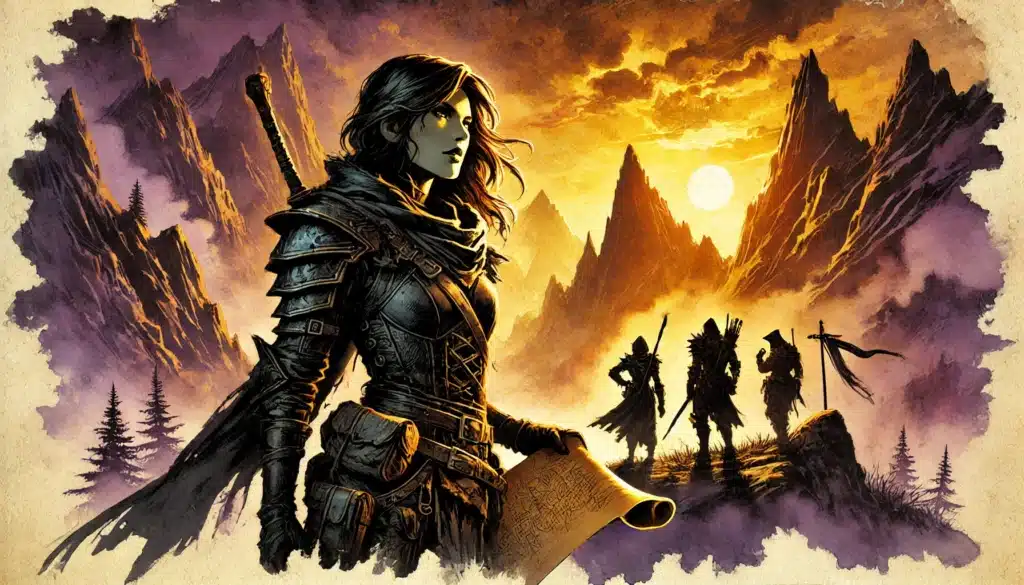
Incorporating Player Roles in Exploration
Assigning specific roles within exploration enhances teamwork and ensures that each player makes meaningful contributions to the group’s overarching goals. By designating roles such as navigator, cartographer, or scout, the party is equipped to tackle the diverse challenges and opportunities inherent in exploration.
- Navigator: Charts courses, forecasts routes, and maintains awareness of orientation.
- Cartographer: Maps discovered areas, annotating key environmental and cultural features.
- Scout: Conducts reconnaissance ahead of the group, gathering intelligence and ensuring safety.
- Naturalist: Observes and identifies flora, fauna, and environmental patterns.
- Quartermaster: Manages resources, supplies, and logistics for extended exploration.
- Historian: Chronicles the adventure’s progression, cultural encounters, and discoveries.
- Interpreter: Facilitates communication and negotiation with encountered societies.
- Trailblazer: Establishes paths or assists in overcoming obstacles encountered in terrain.
- Protector: Defends against threats, ensuring group safety and security.
- Harbinger: Reads omens, signs, or divinations that inform the group’s decisions.
- Strategist: Formulates plans based on gathered intelligence to achieve exploration objectives.
These roles create deeper engagement, as players take on responsibilities aligned with their characters’ strengths and expertise. Each role contributes to the group’s ability to navigate through the campaign’s world, fostering collaboration and synergy.
Integrating player roles into exploration encourages dynamic and interactive gameplay. It allows players to showcase their characters’ unique skills and aberratories, deepening their involvement in the adventure. These roles invite meaningful contributions and reinforce the bonds of camaraderie and teamwork within the party, enriching the exploration experience for each participant.
Building Unique Exploration Rewards
Designing rewards that stand out amidst exploration enhances player investment by offering incentives that are meaningful and personalized. Whether through treasures tied to a character’s backstory or lore-driven artifacts, these rewards create emotional resonance and excitement.
| Reward Type | Description | Gameplay Impact |
|---|---|---|
| Personalized Treasures | Items or artifacts linked to characters’ personal lore | Enhances character development and engagement |
| Lore-Based Artifacts | Objects imbued with cultural or historical significance | Provides deeper world-building context and insights |
| Spiritual Enlightenment | Experiences that offer personal or philosophical growth | Adds depth to character identities and motivations |
| Legendary Relics | Rare and powerful items of mythological origin | Offers impactful abilities or unique gameplay mechanics |
| Bonded Companions | Forming connections with magical creatures or sentient beings | Offers utility, story integration, or emotional resonance |
| Elemental Synergies | Align with specific elemental forces, gaining associated powers | Enhances abilities and tactical versatility |
| Prophetic Visions | Glimpses of future events or destinies | Guides narrative direction and decision-making |
| Harmonious Echoes | Music, sounds, or melodies tied to special abilities | Unlocks new skills or augmentations |
| Ancestral Recollections | Access to ancestral memories or skills | Expands character backstory and influences tactics |
| Cultural Artifacts | Gain cultural artifacts from various societies | Enables diplomacy or understanding of diverse cultures |
| Resource Conduits | Access to abundant resources specific to the terrain | Supports crafting, trade, or strategic advantage |
| Arcane Resonators | Amplify magical abilities through attunement | Enhances spellcasting potential or magical capacity |
| Geographical Mastery | Attains a deeper connection to the land | Offers increased mobility or survival enhancements |
Tailoring rewards to align with players’ backstories or campaign themes creates surprise and wonder. This personal touch enhances the sense of progression and investment, as characters perceive their accomplishments as meaningful and unique milestones within the larger narrative.
Unique rewards offer more than just mechanical benefits. They symbolize characters’ growth and contributions, fostering a sense of connection with the world and campaign. By designing rewards that resonate with players’ motivations and desires, DMs nurture a campaign enriched by exploration that is both rewarding and emotionally impactful.
Encouraging Player Creativity in Exploration
Fostering player-driven exploration emphasizes collaborative storytelling and problem-solving, inviting players to take initiative and craft their journeys.
- Environmental Storytelling: Use of environmental cues and settings to convey narratives and immerse players.
- Interactive NPCs: Introduce characters that offer or request guidance, introducing layers to the story.
- Layered Clues: Offer clues embedded in the environment or narrative to unravel puzzles or mysteries.
- Makeshift Tools: Encourage players to create or repurpose tools to overcome obstacles.
- Creative Negotiation: Engage players in unique interactions or diplomatic resolutions with characters or groups.
- Customized Challenges: Tailor challenges to suit characters’ abilities and traits, encouraging personalized problem-solving.
- Character-Driven Encounters: Design encounters that build on or challenge characters’ personal arcs.
- Infinite Loops: Encourage repetition with variation as players explore scenarios that evolve over time.
- Dynamic Environments: Introduce shifting conditions or settings that affect player choices.
- Linked Questlines: Intertwine multiple quests with central narrative threads for exploration depth.
- Historical Echoes: Shape current events through immersion in past scenarios, encouraging creative interpretation.
By encouraging players to develop creative solutions and take initiative, exploration becomes a collaborative effort, with players realizing their agency in influencing the outcome of events. Players may negotiate alliances with local tribes, creatively craft tools to navigate unyielding obstacles, or decipher cryptic clues to uncover hidden truths—each action revealing the multi-faceted possibilities of their decisions.
Through collaborative exploration, players embrace storytelling not as passive participants but as active creators. They shape their adventures by building narratives that reflect their goals, choices, and perspectives. This empowerment enhances engagement, allowing players to immerse themselves more deeply into the campaign’s ever-evolving tapestry of wonder and intrigue.
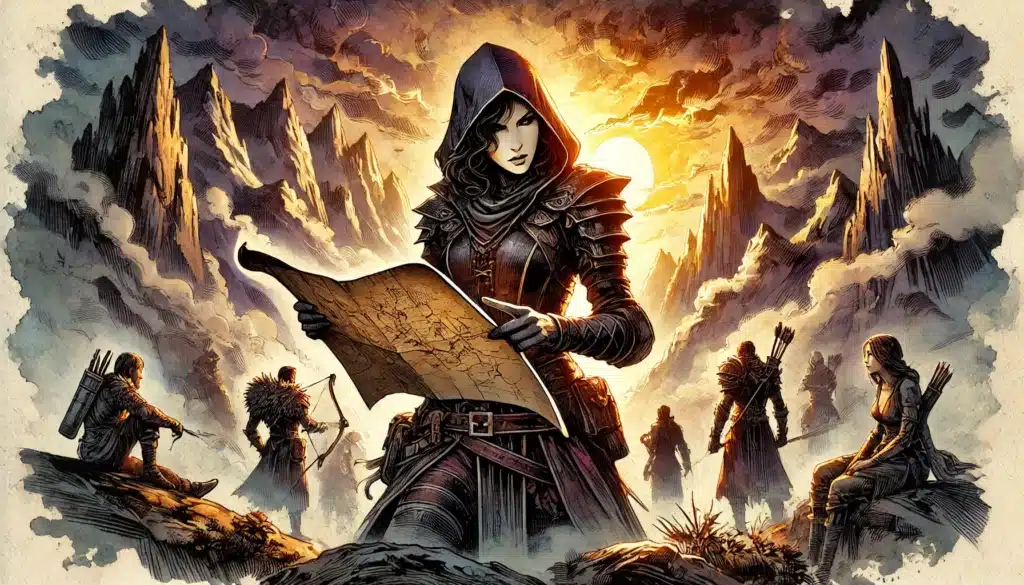
Scaling Exploration Mechanics for Different Campaign Styles
Scaling exploration mechanics to suit different campaign styles enriches gameplay by aligning exploration with the unique qualities of each campaign.
| Campaign Type | Suggested Mechanic | Benefits |
|---|---|---|
| Sandbox Worlds | Incorporating open-world exploration and player agency | Encourages freeform creativity and narrative development |
| High-Fantasy Epics | Elemental domains and mythic quests tied to narrative arcs | Creates expansive world-building and epic challenges |
| Mystery and Intrigue | Clue-based exploration and interconnected storylines | Engages critical thinking and problem-solving |
| Urban and Political | Cultivating alliances and manipulating political landscapes | Encourages negotiation and strategic gameplay |
| Survival and Wilderness | Focus on resource management, survival, and environmental adaptation | Creates immersive experiences with realistic challenges |
| Historical and Cultural | Emphasizing historical or cultural exploration perspectives | Provides socio-political and cultural depth |
| Horror and Thriller | Survival-based, with heightened suspense and psychological elements | Elicits tension and emotional immersion |
| Exploration with Random Generators | Introduce dynamic scenes and events with random generators | Ensures varied, unpredictable experiences |
| Science Fiction and Futuristic | Utilizing futuristic environments and alien landscapes | Cultivates extensive world-building and speculative fiction |
| Steampunk Adventures | Mechanized puzzles and technological enigmas | Incorporates steampunk aesthetics and innovative exploration |
| Linear Narratives | Orchestering closely tied exploration arcs | Strengthens focused storytelling and narrative harmony |
| Cooperative Sessions | Promotes teamwork or collaborative puzzle-solving | Fosters shared experiences and synergy |
By adjusting mechanics to align with each campaign type, DMs create coherent exploration experiences that match player expectations and contribute to the overall campaign narrative.
Through thoughtful scaling, exploration evolves from exploration into a multi-dimensional journey, celebrating the unique qualities of each campaign type while enhancing players’ enjoyment and engagement.
Exploration as a Tool for Immersion
Gamified exploration breathes life into D&D sessions by transforming exploration from a routine task into an integral part of the narrative. By introducing thoughtful mechanics tailored to character interests, Dungeon Masters can craft adventures that inspire curiosity and discovery. This process involves setting clear exploration goals, designing challenging environments, and rewarding players with meaningful outcomes that impact the story and character development.
Players become active participants in the world-building process, influencing the campaign’s direction and depth through their choices. As adventurers journey through the campaign, their discoveries—be it hidden treasures, forgotten lore, or new alliances—elevate the gameplay experience and foster deeper emotional connections between the characters and the narrative.
⚔️ Fantasy RPG Random Tables Books
Make life as a Gamemaster easier…
If you play Dungeons & Dragons, Pathfinder, or other fantasy RPGs, this
RPG random tables series
is packed with encounters, NPCs, treasure, and more. Available in eBook or print—either way, you’ll have a wealth of adventure ideas at your fingertips.
Through exploration, players not only learn about the world around them but also gain insights into their characters’ growth and evolving relationships. This shared journey, enriched with creative storytelling, becomes a memorable tapestry of triumphs and challenges. DMs are encouraged to experiment with various mechanics, adapting them to align with the interests and dynamics of their group, ensuring that exploration remains a dynamic and engaging pillar of their campaign.

